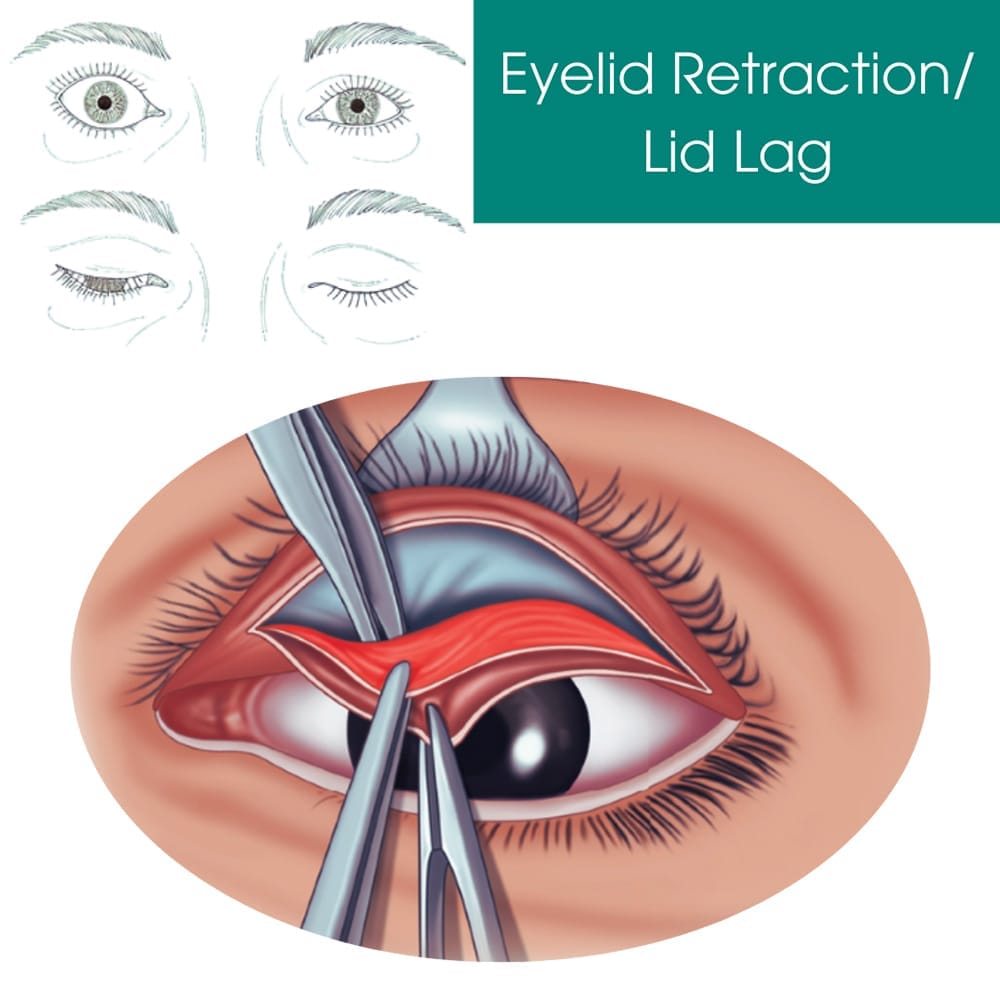 Eyelid retraction, also known as lid lag, is a condition in which the upper eyelid is abnormally positioned, exposing more of the iris and, in some cases, the white part of your eye. Lower eyelid retraction, which is less common, occurs when the lower eyelid is positioned lower than normal, resulting in a droopy appearance and likely exposes the lower part of the iris. This can make is seem as if you’re startled or staring wide-eyed, generating concerns about your appearance and overall health.
Eyelid retraction, also known as lid lag, is a condition in which the upper eyelid is abnormally positioned, exposing more of the iris and, in some cases, the white part of your eye. Lower eyelid retraction, which is less common, occurs when the lower eyelid is positioned lower than normal, resulting in a droopy appearance and likely exposes the lower part of the iris. This can make is seem as if you’re startled or staring wide-eyed, generating concerns about your appearance and overall health.
While not as common as other eye conditions such as refractive errors or dry eye syndrome, eyelid retraction is a significant worry for those affected due to its potential impact on vision, appearance and general well-being of the eyes. Eye Physicians in NYC has a team of trained optometrists and eye doctors dedicated to correctly diagnosing and managing lid lag. Their quick and competent eyelid retraction repair restores normal eyelid function and relieves any associated pain.
Other than eyelid retraction repair, their practice also offers treatment options for a wide range of other conditions too for your entire family, including children, such as for:
Symptoms of eyelid retraction vary depending on the underlying cause and severity of the disease. If you’re experiencing eyelid retraction along with symptoms, however, such as dryness or discomfort, you should seek medical attention immediately.
The most common symptoms of lid lag include:
Lid lag is a functional disability that affects eyesight and blinking. Aside from these common symptoms, eyelid retraction might create more complicated symptoms.
Some of the more complicated symptoms related to eyelid retraction can include:
Eyelid retraction that leads to a need for lower eyelid retraction surgery or surgical repair of the eyelid can be caused by a variety of factors, including:
Eyelid retraction is diagnosed after a thorough medical history and physical examination by an eye specialist. This includes evaluating eyelid posture and movement. Measurement techniques measure the extent of retraction, and imaging procedures such as ultrasound or MRI scans identify structural problems. Blood testing detects thyroid dysfunction or autoimmune diseases.
Early diagnosis and appropriate management make effective treatment possible. Treatment options for eyelid retraction vary depending on the underlying cause and severity of the condition.
Some frequently used treatments include:
If eyelid retraction is caused by an underlying disease, such as thyroid eye disease, the condition must be treated appropriately to properly control the retraction. Other than these approaches, surgical repair of the eyelid may be required, particularly if the retraction is significant or causing vision loss.
Several eyelid retraction surgery methods can be performed based on your needs, including:
Lower lid retraction surgery is an option when conservative treatments such as artificial tears, lubricating ointments or eyelid workouts are ineffective, or when the retraction is significant and causes functional or cosmetic problems. Lower eyelid retraction surgery seeks to rectify the position of the lower eyelid about the eye, restoring normal eyelid function and appearance.
Common surgical procedures for lower lid retraction include:
Lower eyelid retraction prevention involves using precautions during activities, leading a healthy lifestyle, not smoking, practicing proper eye care and getting regular eye checkups. Don’t let eyelid retraction affect your vision or confidence. Contact the skilled doctors at Eye Physicians in NYC. With their experience and individualized treatment, you can feel confident that your problem will be properly addressed and with each visit, you can be assured of getting in and out of the office in under an hour.
Eye Physicians
110 Lafayette St, Suite 503
New York, NY 10013
(212) 292-4814
Entrust the care of your precious eyesight to highly skilled and experienced eye care professionals. For top-notch ophthalmologists and optometrists in Downtown Manhattan, choose Eye Physicians. Eye Physicians ensures prompt care, precise diagnosis, and personalized treatment plans.
Schedule an Appointment